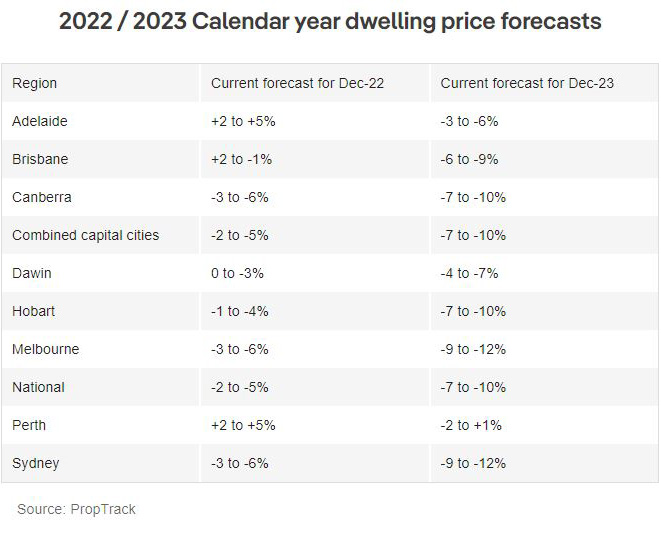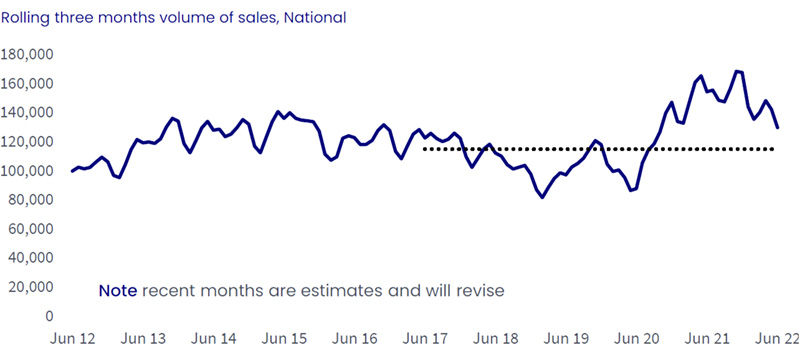Bleak outlook for property as prices tipped to fall by 12 per cent
Property prices have been tipped to fall by as much as 12 per cent in the most expensive capitals, according a major new report, although two cities shaped as an exception to the downward trend.
Property prices have been tipped to fall 5 per cent by Christmas and even further next year, as interest rate hikes bite, and more properties come up for sale and spend more time on the market.
A report released by PropTrack on Thursday (28 July) has forecast national price drops fall of between 2 and 5 per cent by the end of this year and by a further 7 to 10 per cent by the end of next year.
It revealed Sydney and Melbourne will lead the falls, while Adelaide and Perth still had growth through this year before easing back in 2023.
Cameron Kusher, Director of Economic Research at PropTrack, said the Reserve Bank of Australia’s moves have further slowed price growth and resulted in some falls over recent months, with more to come.
“The recent run-up in prices, coupled with reducing borrowing capacities as interest rates rise, is likely to see price falls broaden and then accelerate further into 2023, with the more expensive cities expected to record the largest price falls,” Mr Kusher said.
Official interest rates having already risen from 0.1 per cent to 1.35 per cent and are expected to rise much higher over the coming months.
The impact on property prices has been immediate.
Real estate prices have slipped below their recent peaks in Sydney (-1.5 per cent), Melbourne (-1.8 per cent), Brisbane (-0.1 per cent), Darwin (-0.6 per cent), and Canberra (-0.5 per cent), while the rate of growth continues to slow elsewhere.

While the capital cities are in the spotlight, regional areas are also predicted to take a hit.
“Demand for regional properties is also likely to slow and given prices have seen stronger growth in these areas than within the capital cities, we expect to see price falls in these markets too,” Mr Kusher said.
The data was analysed by the REA Group in its PropTrack Property Market Outlook July 2022 Report, which combines a comprehensive analysis of the residential property market with an outlook for the year ahead.
The price falls come as Australia recorded an unprecedented 34 per cent increase in prices for homes since 2020 when the pandemic began.
More stock, bigger falls
Interest rate rises are driving the price falls, with the snowballing effect of more listings hitting the market further dampening prices through greater supply.
Complemented by winter’s traditional shortage of buyers, prices are being assaulted from multiple angles.
Nationally, new listings have risen by an average of 18.9 per cent between winter and spring, with the peak listing month being October, followed closely by November. The seasonal rise in new listings through spring and early summer is likely to test the market this year, according to Tim Lawless, Research Director, CoreLogic Australia.
“With housing demand already trending lower, as demonstrated by fewer home sales across some regions, it’s likely overall advertised supply levels will rise more substantially through the final quarter of the year and into 2023,” Mr Lawless said.
“Higher levels of advertised supply implies more choice for buyers but also more competition for vendors and, ultimately, higher inventory levels would add further dampening pressure on housing values as homes take longer to sell, motivating vendors to discount their pricing expectations by a larger amount.”
Longer sell times
Interest rates remain the primary catalyst for the forecast of continued price falls.
“While there were already some signs that the rate of price growth was slowing at the beginning of this year, we were not expecting interest rates to rise until early 2023,” PropTrack's Mr Kusher said.
“There’s since been an outbreak of inflation, resulting in the RBA lifting rates in each of the three months to July 2022, and this has taken the cash rate from 0.1 per cent to 1.35 per cent and further rate increases are anticipated.”
Mr Kusher said he expected the cash rate to rise between 2.5 per cent to 3 per cent by the end of this year, with some further increases in early 2023.
“Thereafter, we expect rates to remain on hold with the potential for them to be reduced in late 2023 or early 2024,” he said.
Concern over interest rate rises is already playing out in lower clearance rates, higher time on market and larger rates of vendor discounting, although there is a significant level of variability from region to region depending on the balance between buyers and sellers.

Median days on market in Sydney increased to 33 days through the June quarter (from 23 days a year ago) and Melbourne median days on market has increased from 27 days a year ago to 30 days through the June quarter.
At the other end of the spectrum, Perth homes are selling in an average of just 18 days, equal to the median days on market last year.



















